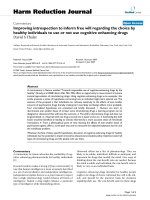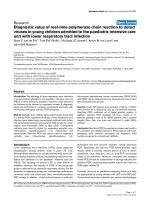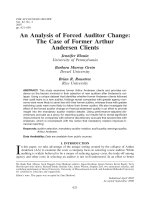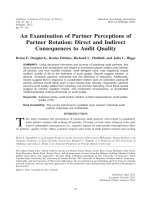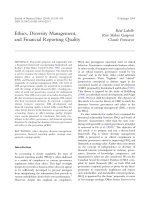Acharya et al the social value of the financial sector; too big to fail or just too big (2014)
Bạn đang xem bản rút gọn của tài liệu. Xem và tải ngay bản đầy đủ của tài liệu tại đây (4.5 MB, 536 trang )
THE SOCIAL VALUE OF
THE FINANCIAL SECTOR
Too Big to Fail or Just Too Big?
8865hc.9789814520287_tp.indd 1
18/9/13 10:12 AM
World Scientific Studies in International Economics
(ISSN: 1793-3641)
Series Editor
Robert M. Stern, University of Michigan and
University of California-Berkeley, USA
Editorial Board Vinod K. Aggarwal, University of California-Berkeley, USA
Alan Deardorff, University of Michigan, USA
Paul DeGrauwe, Katholieke Universiteit Leuven, Belgium
Barry Eichengreen, University of California-Berkeley, USA
Mitsuhiro Fukao, Keio University, Tokyo, Japan
Robert L. Howse, New York University, USA
Keith E. Maskus, University of Colorado, USA
Arvind Panagariya, Columbia University, USA
Vol. 22
International Trade Policy Formation: Theory and Politics
by Wolfgang Mayer (University of Cincinnati, USA)
Vol. 23
Priorities and Pathways in Services Reform:
Part I — Quantitative Studies
edited by Philippa Dee (Australian National University, Australia)
Vol. 24
Globalizing Information: The Economics of International Technology Trade
by Keith E Maskus (University of Colorado at Boulder, USA)
Vol. 25
Priorities and Pathways in Services Reform: Part II — Political Economy Studies
edited by Christopher Findlay (University of Adelaide, Australia)
Vol. 26
World Trade Organization and International Trade Law: Antidumping,
Subsidies and Trade Agreements
by Gary N Horlick (Law Offices of Gary N Horlick, USA & University of Bern,
Switzerland)
Vol. 27
European Economic Integration, WTO Membership, Immigration and Offshoring
by Wilhelm Kohler (University of Tübingen, Germany)
Vol. 28
Services Trade Reform: Making Sense of It
by Philippa Dee (Australian National University, Australia)
Vol. 29
The Social Value of the Financial Sector: Too Big to Fail or Just Too Big?
edited by Viral V Acharya (New York University, USA & Centre for Economic Policy
(CEPR), UK), Thorsten Beck (Tilburg University, The Netherlands & Centre for
Economic Policy (CEPR), UK), Douglas D Evanoff (Federal Reserve Bank of
Chicago, USA), George G Kaufman (Loyola University Chicago, USA), &
Richard Portes (London Business School, UK & Centre for Economic Policy
(CEPR), UK)
Vol. 30
The Role of Central Banks in Financial Stability: How Has It Changed?
edited by Douglas D Evanoff (Federal Reserve Bank of Chicago, USA),
Cornelia Holthausen (European Central Bank, Germany), George G Kaufman
(Loyola University Chicago, USA) & Manfred Kremer (European Central Bank,
Germany)
The complete list of the published volumes in the series can be found at
/>
29
World Scientific
Studies in
International
Economics
THE SOCIAL VALUE OF
THE FINANCIAL SECTOR
Too Big to Fail or Just Too Big?
Editors
Viral V Acharya
New York University, USA & Centre for Economic Policy (CEPR), UK
Thorsten Beck
Tilburg University, The Netherlands & Centre for Economic Policy (CEPR), UK
Douglas D Evanoff
Federal Reserve Bank of Chicago, USA
George G Kaufman
Loyola University Chicago, USA
Richard Portes
London Business School , UK & Centre for Economic Policy (CEPR), UK
World Scientific
NEW JERSEY
•
LONDON
8865hc.9789814520287_tp.indd 2
•
SINGAPORE
•
BEIJING
•
SHANGHAI
•
HONG KONG
•
TA I P E I
•
CHENNAI
18/9/13 10:12 AM
Published by
World Scientific Publishing Co. Pte. Ltd.
5 Toh Tuck Link, Singapore 596224
USA office: 27 Warren Street, Suite 401-402, Hackensack, NJ 07601
UK office: 57 Shelton Street, Covent Garden, London WC2H 9HE
Library of Congress Cataloging-in-Publication Data
Acharya, Viral V.
The social value of the financial sector : too big to fail or just too big? / by Viral V Acharya
(New York University, USA & Centre for Economic Policy (CEPR), UK), Thorsten Beck (Centre
for Economic Policy (CEPR), UK & Tilburg University, The Netherlands), Douglas D Evanoff
(Federal Reserve Bank of Chicago, USA), George G Kaufman (Loyola University Chicago, USA)
& Richard Portes (Centre for Economic Policy (CEPR), UK & London Business School , UK).
pages cm. -- (World scientific studies in international economics, ISSN 1793-3641 ; 29)
Includes bibliographical references and index.
ISBN 978-9814520287
1. Financial institutions. 2. Financial institutions--Government policy. 3. Banks and banking.
4. Social policy. I. Title.
HG173.A224 2013
332.1--dc23
2013027960
British Library Cataloguing-in-Publication Data
A catalogue record for this book is available from the British Library.
Cover Illustration by Ping Homeric.
Copyright © 2014 by World Scientific Publishing Co. Pte. Ltd.
All rights reserved. This book, or parts thereof, may not be reproduced in any form or by any means,
electronic or mechanical, including photocopying, recording or any information storage and retrieval
system now known or to be invented, without written permission from the Publisher.
For photocopying of material in this volume, please pay a copying fee through the Copyright
Clearance Center, Inc., 222 Rosewood Drive, Danvers, MA 01923, USA. In this case permission to
photocopy is not required from the publisher.
In-house Editors: Sandhya Venkatesh/Dipasri Sardar
Typeset by Stallion Press
Email:
Printed in Singapore
September 17, 2013
11:3
Social Value of the Financial Sector: Too Big to Fall or Just Too Big
9in x 6in
Preface
The large-scale damage inflicted on the economies of countries throughout the world by the financial crisis of 2007 to, at least, 2010, has ignited
widespread re-evaluation of the net social benefits derived from large and
growing domestic and international financial sectors. These sectors tended
to expand much faster before the crisis than did their national GDPs. For
example, the aggregate on-balance-sheet dollar size of the 11 major types
of US financial institutions included in the Federal Reserve’s flow of funds
data more than doubled from 1.27% of GDP in 1970 to 2.85% of GDP
in 2007.
A large number of empirical research studies have provided evidence
that deeper and more efficient financial systems are associated in the longer
run with higher and more rapid economic growth. But periodically, the system crashes, and the larger the system, the deeper and broader the damage.
Does the damage partially, totally, or more than totally offset the gains realized from the financial sector during noncrisis periods? We typically think
of market distortions, and resulting adverse welfare effects, from having
financial institutions that are too-big-to-fail. However, it may be that in
certain cases, the financial sector is simply too big, resulting in inefficiencies and generating societal welfare losses. If this is the case, how can public
policy do something about it?
These were some of the major questions addressed by participants
at the Fifteenth Annual Federal Reserve Bank of Chicago International
Banking Conference, cosponsored with the Centre for Economic Policy
Research (CEPR) in London. The conference was held in Chicago on
November 15–16, 2012. Some 175 participants, representing policymakers,
financial regulators, financial practitioners, researchers, and academics
from some 30 countries participated. Specific topics discussed included
the costs and benefits of the current financial industry structure, social
benefits from financial industry innovation, effects of regulation on societal welfare, the financial situation and resulting economic activity across
v
b1606-fm
September 17, 2013
vi
11:3
Social Value of the Financial Sector: Too Big to Fall or Just Too Big
9in x 6in
Preface
countries, and the potential benefits and costs associated with the breaking
up of large banks.
This volume includes the papers presented at the Chicago conference,
including the keynote addresses by leading experts in the field. The publication of the papers in this volume is intended to disseminate the conference ideas, analyses, and conclusions to a wider audience. Hopefully, that
broader distribution will generate additional discussion, serve as the basis
for further analyses, and be used to guide public policy.
b1606-fm
September 17, 2013
11:3
Social Value of the Financial Sector: Too Big to Fall or Just Too Big
9in x 6in
Acknowledgments
Both the conference held at the Federal Reserve Bank of Chicago, November 15–16, 2012, and this volume represent a joint effort of the Federal
Reserve Bank of Chicago and the Centre for Economic Policy Research
(CEPR). Various people at each institution contributed to the effort. The
five editors served as the principal organizers of the conference program and
would like to thank all the people who contributed their time and energy
to the effort. At the risk of omitting some people, we would like to thank
Julia Baker, John Dixon, Ella Dukes, Ping Homeric, and Rita Molloy. Special
mention should be accorded Kathryn Moran, who managed the Chicago
Fed’s web effort; Sandy Schneider, who expertly managed the conference
administration; as well as Helen O’D. Koshy and Sheila Mangler, who had
primary responsibility for preparing the manuscripts for this book.
vii
b1606-fm
September 17, 2013
11:3
Social Value of the Financial Sector: Too Big to Fall or Just Too Big
This page intentionally left blank
9in x 6in
b1606-fm
September 17, 2013
11:3
Social Value of the Financial Sector: Too Big to Fall or Just Too Big
9in x 6in
b1606-fm
Contents
Preface
v
Acknowledgments
Part I.
Chapter 1.
vii
Keynote Addresses
1
A Ferment of Regulatory Proposals
3
Charles A. E. Goodhart
Chapter 2.
Progress and Priorities for Financial Reform
11
Mary John Miller
Part II. Description and Measurement
of the Financial System
Chapter 3.
What Is Meaningful Banking Reform, Why Is It
So Necessary … and So Unlikely?
21
23
Charles W. Calomiris
Chapter 4.
The Great Leveraging
33
Alan M. Taylor
Chapter 5.
Finance and Economic Development
in a Model with Credit Rationing
67
Jean-Louis Arcand, Enrico Berkes, and Ugo Panizza
Chapter 6.
Too Much Finance, Too Much Credit?
Comments on Papers by Calomiris,
Arcand–Berkes–Panizza, and Taylor
Eugene N. White
ix
81
September 17, 2013
11:3
Social Value of the Financial Sector: Too Big to Fall or Just Too Big
x
Part III.
Chapter 7.
9in x 6in
b1606-fm
Contents
Social Benefits and Costs of the Current
Financial System
Bank Regulatory Reforms and Racial
Wage Discrimination
89
91
Ross Levine, Alexey Levkov, and Yona Rubinstein
Chapter 8.
Finance: Economic Lifeblood or Toxin?
109
Marco Pagano
Chapter 9.
Finance: Is Bigger Badder?
147
Gerard Caprio, Jr.
Part IV.
Financial Industry Innovation
Chapter 10. A Proposal for the Resolution of Systemically
Important Assets and Liabilities: The Case
of the Repo Market
157
159
Viral V. Acharya and T. Sabri Öncü
Chapter 11. Reexamining Financial Innovation
after the Global Financial Crisis
215
W. Scott Frame and Lawrence J. White
Chapter 12. Financial Innovation and Shadow Banking
229
Luc Laeven
Part V.
Effects of Regulation, the Safety Net and Other
Government Guarantees
Chapter 13. Evolving Intermediation
Nicola Cetorelli
237
239
September 17, 2013
11:3
Social Value of the Financial Sector: Too Big to Fall or Just Too Big
Contents
Chapter 14. The Socially Optimal Level of Capital
Requirements: A View from Two Papers
9in x 6in
b1606-fm
xi
257
Javier Suarez
Chapter 15. Effects of Regulation, the Safety Net, and Other
Government Guarantees
267
Mathias Dewatripont
Part VI. Finance and Economic Activity: Variations
across Emerging and Developed Markets
273
Chapter 16. Legal and Alternative Institutions in Finance
and Commerce
275
Franklin Allen and Jun “QJ” Qian
Chapter 17. Finance in the Tropics: Understanding
Structural Gaps and Policy Challenges
303
Thorsten Beck
Chapter 18. Foreign Banks: Access to Finance
and Financial Stability
323
Neeltje van Horen
Chapter 19. Institutions, Finance, and Economic Activity:
Views and Agenda
345
Elias Papaioannou
Part VII.
Break Up the Big Banks?
Chapter 20. Breaking (Banks) Up Is Hard to Do:
New Perspective on Too Big to Fail
375
377
James R. Barth and Apanard (Penny) Prabha
Chapter 21. Restructuring the Banking System to Improve
Safety and Soundness
Thomas M. Hoenig and Charles S. Morris
401
September 17, 2013
11:3
Social Value of the Financial Sector: Too Big to Fall or Just Too Big
xii
9in x 6in
Contents
Chapter 22. Ending Too Big to Fail: A Proposal for Reform
427
Richard W. Fisher and Harvey Rosenblum
Part VIII. Where to From Here? The Implications
for Financial Regulatory Policy
445
Chapter 23. Where to from Here? Implementation,
Implementation, Implementation
447
Claudio Borio
Chapter 24. Complexity in Financial Regulation
455
Andrew G. Haldane and Vasileios Madouros
Chapter 25. Financial Reform: On the Right Road,
at the Right Pace?
465
Thomas F. Huertas
Chapter 26. Banking Regulation and Supervision
in the Next 10 Years and Their
Unintended Consequences
471
Danièle Nouy
Chapter 27. The Social Value of the Financial Sector: Where
to from Here?
503
Barbara A. Rehm
Chapter 28. Public Policy Options
511
Jürgen Stark
Agenda
519
Index
523
b1606-fm
September 17, 2013
11:2
Social Value of the Financial Sector: Too Big to Fall or Just Too Big
PART I
KEYNOTE ADDRESSES
1
9in x 6in
b1606-ch01
September 17, 2013
11:2
Social Value of the Financial Sector: Too Big to Fall or Just Too Big
This page intentionally left blank
9in x 6in
b1606-ch01
September 17, 2013
11:2
Social Value of the Financial Sector: Too Big to Fall or Just Too Big
9in x 6in
A Ferment of Regulatory Proposals
Charles A. E. Goodhart∗
London School of Economics
A Simpler Approach?
The financial crisis has spawned a ferment of ideas for improving regulation. As with most fermentation, some rather odd notions have bubbled up
to the surface. One such is that there was a golden era in the past, between
World War II and the 1970s, when banking was simple, straightforward, and
trustworthy; banking crises were nonexistent; and, as an ordinary depositor, one could actually talk personally to one’s bank manager, either face to
face or over the phone.
Actually in my country, the UK, those conditions were primarily
achieved by direct controls over both the amount of bank lending to the
private sector, and often its direction between sectors, and by a rigorous
suppression of competition in the financial sector. All parts of finance were
cartelized, and rates were set via such central cartels, all with the vocal
encouragement of the authorities. You could, indeed, talk to your bank
manager, but he (there were no “shes”) was programmed to say “no.”
From the late 1960s onward, a small group of us in the Bank of England,
led by John Fforde but including Eddie George and Andrew Crockett, campaigned to end this tightly controlled system, and in 1971 we succeeded with
the publication of “Competition and Credit Control.” The competitioneasing aspect worked fine, but during the subsequent 1972–1973 boom
the credit control left much to be desired, not least because of political
constraints over the flexible use of the interest rate weapon.
∗ Charles Goodhart is Emeritus Professor of Banking and Finance in the Financial Mar-
kets Group at the London School of Economics.
3
b1606-ch01
September 17, 2013
4
11:2
Social Value of the Financial Sector: Too Big to Fall or Just Too Big
9in x 6in
C. A. E. Goodhart
More recently, interest rates have been predicated to the primary need
to achieve an inflation target, and that, once again, has meant that, during a
contemporaneous housing boom, interest rates could not be, or at any rate
were not, used to stabilize credit and asset price expansion. This has led to
proposals for other instruments of control, in particular via macroprudential regulatory control. There is, however, a problem here. If regulation is to
be effective, it must have the effect of preventing the regulated from doing
what they want to do. So they will attempt to avoid it. Usually they succeed,
though perhaps only after a time. As Ed Kane has argued, there is a dialectic
in the regulatory process: Crisis leads to regulation, which begets avoidance
and erosion, which begets crisis, and so on ad infinitum. Let me coin an
aphorism, “If regulation is simple, it will be simple to avoid it.” The Basel
I risk buckets were simple, and they were simply avoided, for example, via
securitization.
Indeed this suggests a second dialectic. We start with a simple regulatory
proposal. The regulated then find some fairly easy ways around it. This leads
to a more complicated and lengthy second round of regulations to prevent
or mitigate such avoidance measures. These more complicated measures in
themselves then open up further ways of trying to avoid such regulations,
which, in turn, leads to a vastly more complex third stage of countervailing
measures. At this point the regulations run into hundreds of pages, and
no one is quite sure quite how they operate, if they operate effectively at
all. At this juncture the cry goes up that we must revert to a simpler system. This proposal has obvious advantages, and so we start on yet another
cycle.
Incidentally I have never owned, and have rarely seen, a dog that could
catch frisbee, which, as you may recall, was the title of Andy Haldane’s
much-quoted paper at the latest Jackson Hole Conference, arguing for
more simplicity in regulation. Perhaps that was because my dogs took after
their owner in being resolutely nonmathematical. Indeed, my cairn terriers
would have regarded chasing plastic Frisbees rather than flesh-and-blood
squirrels as below their dignity.
Almost all regulatory structures, on their own, can be avoided and
manipulated. The direction and channeling of the recent crisis was considerably influenced by regulatory arbitrage between US banks, which were
subject to an overall leverage limit but not to Basel II, and US broker–dealers
b1606-ch01
September 17, 2013
11:2
Social Value of the Financial Sector: Too Big to Fall or Just Too Big
A Ferment of Regulatory Proposals
9in x 6in
b1606-ch01
5
and European banks, which were subject to Basel II but not to a simple
leverage ratio. What happened, unsurprisingly, was that the Basel II banks
gorged on supposedly low-risk leverage expansion, while the US banks took
on the riskier tranches of MBS, and indeed suffered higher losses per unit
of assets than their European counterparts.
In my view, the Europeans came off worst in this exchange, partly
because risk weighting is inherently defective. The riskiness of an asset
is not constant over time, but context dependent, even more so in the face
of innovation. Moreover, the risk weights adopted are inevitably somewhat
subject to political interference involving the exercise of national interest, as
witnessed by the long saga of what risk weight to attach to the government
bonds of other states. Governments, as well as private sector agents, can be
subject to conflicts of interest. Thus, I personally am sorry that Basel III
still places much more emphasis on risk-weighted ratios than on a simpler
leverage ratio, with the latter being so permissive, at 33 to 1, that it is hardly
more than a back-up minimal protection; though I would just note, en
passant, that the central banks themselves are not now practicing what they
preach in this respect. I hesitate to calculate their own leverage ratios in
case I might scare someone.
I would prefer to shift the regulatory balance more toward the simpler
overall leverage ratio, but to believe that by itself would suffice is to forget my prior aphorism. Simple leverage ratios can be overcome by taking
on riskier assets, by accounting tricks, and by disintermediating over the
boundary between what is included and what excluded in both the numerator and denominator. I would certainly not go so far as to promote a theory
about the conservation of risk, but nevertheless much regulation has more
influence on the locus where risk becomes concentrated rather than its
overall extent. Nevertheless, the greater reliance in the US on simpler leverage ratios did help to limit the size, and hence the potential damage from
the financial sector here, in contrast to Europe.
It has now become fashionable in economics to switch our similes from
physics to epidemiology and ecology. In that vein, let me note that when a
dangerous condition is resistant to a single antidote, it can often be treated
by a cocktail of drugs. In the field of regulation that means that we should
not aim to rely on a single approach, but use both risk-weighted and overall
simple leverage ratios, belt and braces.
September 17, 2013
11:2
Social Value of the Financial Sector: Too Big to Fall or Just Too Big
6
9in x 6in
C. A. E. Goodhart
How to Get from Here to There
There are many who might claim that this issue of how to design the regulatory approach, i.e., risk-weighted, or simple leverage, or both, or something
else again, is a second-order problem. The first-order problem was, instead,
that the required amount of loss-absorbing equity capital, and available liquid assets, was just too low. Waving our Modigliani–Miller theorem in the
air, we triumphantly demonstrate that the equilibrium interest rate spreads
would not be much higher, whereas safety would be greatly enhanced, if
normal equity ratios were raised by some sizable multiple over its pre2008 starting point. Moreover, unless the standard, normally maintained,
equilibrium ratio is much higher, how could the authorities possibly lower
required ratios during periods of economic and financial stress, which is
exactly what countercyclical macroprudential policy would imply that you
should do.
Well okay, but such very much higher ratios have two consequential
implications. First, they should not be treated, as they have been in the
past, as reputational lower limits. They must be part of a usable buffer. That
implies devising a ladder of sanctions as banks start to eat into such a large
buffer, and on the need to make a conscious decision on where the bottom,
acceptable limit, beyond which intervention and resolution should occur, is
taken to be. Basel III has made a start in this direction, with the conservation
range between 7% and 4.5% of core tier 1 equity, with banks in this range
being restricted in their payouts to shareholders and management. But
much more needs to be done to change ideas, presentation, and semantics
to shift from treating all regulatory ratios as minimums to having many of
them seen as norms.
But what is more immediately important is that the Modigliani–Miller
analysis represents a comparison of static equilibrium states and has relatively little bearing on the dynamic process of shifting from state 1 to state
2. Indeed, several of our best economists who have been most prominent
in defending Modigliani–Miller from the assault of bankers, for example,
Anat Admati and Martin Hellwig, have been equally vocal in warning that
the dynamic process of trying to move toward a much higher equilibrium
capital ratio is fraught with difficulty and danger.
A combination of debt overhang, miserable price to book equity value
ratios, and bank executives whose wealth is largely tied up with their own
b1606-ch01
September 17, 2013
11:2
Social Value of the Financial Sector: Too Big to Fall or Just Too Big
A Ferment of Regulatory Proposals
9in x 6in
b1606-ch01
7
bank’s equity valuation means that banks will prefer deleveraging to making
new equity issues. The more that regulators force up required ratios now,
the worse will be deleveraging. Some answer that it is the market, not
regulators, who demand higher bank equity ratios. Up to a point, but
remember that so long as such ratios are treated as reputational minimums,
what the market will demand is satisfactory buffers, or margins, above such
regulatory ratios, whereas the latter are set by the regulatory authorities. To
some extent the strong incentive at present not to issue more equity capital
can be partially met by setting regulatory requirements, for the time being
at least, in absolute rather than in ratio format, and using limitations on
payouts to shareholders and bank executives as a sanction, or incentive, to
get from here to there. In all such respects the actions on this front taken
in the US have been much, much better than those in Europe.
Let me next draw your attention to an important recent British development related to the current Funding for Lending Scheme, or FLS. In
economics, especially microeconomics, we are well aware of the important
distinction between marginal and average. We can, and perhaps should,
make that same distinction in regulation. Thus, under the FLS, additional lending to the UK private sector enjoys a waiver of risk-weighted
CARs, while for other assets CARs have been greatly increased. Thus,
by divorcing marginal from average regulatory requirements we can, to
some extent, influence portfolio distribution separately from average safety
requirements. I have advocated doing the same trick with commercial bank
reserves at the central bank by lowering marginal returns, relative to the
average returns on such reserves. One concern that I do have is that such
schemes could be used to reinforce national financial protectionism by
privileging lending at home rather than abroad. Another concern could
be that regulatory instruments, which should be primarily about systemic
safety, could then be increasingly employed for other macroeconomic purposes. But, that said, it is generally better to have more instruments rather
than fewer.
A More Structural Approach
So there are undoubtedly difficulties in moving at all rapidly to a world
in which the norm would be for banks to maintain substantially higher
September 17, 2013
8
11:2
Social Value of the Financial Sector: Too Big to Fall or Just Too Big
9in x 6in
C. A. E. Goodhart
capital (and liquidity) ratios than in the recent past. Moreover, the ease of
avoiding simple regulations suggests that we will have to maintain complex
belt-and-braces combinations of risk-weighted and simpler leverage ratios.
Even then, many would back clever bank employees to circumvent whatever the regulators think up. In this context there is a growing bandwagon
toward a much more dirigiste approach to financial intermediation, constraining what banks can do, and what they are not permitted to do, a more
structural approach. Let me repeat: I saw this latter kind of systemic structural approach personally when I started back in the 1960s and 1970s, and
I did not much like it then. No doubt my views are colored by my personal
experience.
Perhaps the leading example of this approach is to be found in the
recommendation to separate retail and wholesale banking, as advanced by
the British Independent Commission on Banking, the Vickers Report, and
taken on in a marginally different guise by the recent Liikanen Report. It
is far from clear to me why this separate subsidiarization under a single
holding company should make for greater safety. Moreover, the bets that
sank our banks were primarily about lending on property, commercial as
well as residential. Such property-related loans are the bread and butter of
retail banking. One of my legal colleagues in the UK has quipped that the
effect of the separation will be to protect the safer wholesale bank from the
risky retail outlet.
Moreover, with reinforced deposit insurance in place, and the availability of bridge banks, and good bank/bad bank mechanisms, the adverse
externalities of allowing a retail bank to be closed and liquidated are, I
would guess, considerably less than those arising from the closure of a
similar-sized wholesale bank. The latter are likely to be far more interconnected, and their liquidation would, I expect, have a far more widespread
and devastating effect on asset prices and the financial system more generally. The limitation of the public sector’s bailout safety net to the retail
subsidiaries of banks strikes me as owing more to real-politik than to economic analysis.
Apart from the 1981–1982 LDC loan crisis, all the recent periods of
severe financial stress in the UK, 1973–1975, 1991–1992, and 2008–2009,
have all been connected with property price bubbles and busts. The adoption of the Vickers Report will not prevent the next banking crisis in the UK,
b1606-ch01
September 17, 2013
11:2
Social Value of the Financial Sector: Too Big to Fall or Just Too Big
A Ferment of Regulatory Proposals
9in x 6in
b1606-ch01
9
which I forecast will probably occur around 2026–2027, (note the 16-year
gaps between each of the last three cases). Several of the more radical
structuralists, such as Larry Kotlikoff in the US or John Kay in the UK
tend to concur, and to advocate that retail banks get forcibly transformed
into “narrow” banks, holding only short-dated or cash claims on the public
sector.
But narrow bank deposits would have a low return. If one were to
allow broad, wholesale banks to compete by offering transactions related,
short-dated deposits, there would be a hugely procyclical stampede of
such deposits out of broad banks into narrow banks during busts, and in
the opposite direction during good times. Our radical structuralists have,
however, thought of this, and would respond by preventing broad banks
from offering any transactions-related, or short-dated deposits. Such broad
banks could only be financed by equity or by long-dated deposits with significant penalties for early withdrawal. They would be made run-proof by
diktat.
Such a system with narrow banks holding only cash-type assets, and
all other finance done through the equivalent of investment trusts would,
indeed, be safe. But it would also be inflexible and inefficient. Banks currently make promises to potential borrowers that they will be prepared to
lend to them in future, in the form of facilities and overdrafts, at a time
of the borrower’s choosing without the bank having first already obtained
the funding necessary to pay out to the borrower. It can do so because the
bank in turn has, often short-term, lines of credit in wholesale markets,
holds liquid assets, and at a pinch can also borrow from the central bank.
Under the radical structural reforms, the investment banks would be left
entirely reliant on their buffer reservoir of liquid assets for flexibility, or
alternatively on the public sector providing the marginal funding. Either
this buffer would have to expand a lot, which would both reduce the volume
and raise the cost of the residual loans to the private sector, or potential
private sector borrowers would have to queue until the broad banks had
the funds in hand to lend on.
Overall the need for narrow banks to hold public sector debt and for
broad banks to rely on a liquid assets buffer, presumably largely also of
public sector debt, would privilege sales of public sector debt, relative to
private sector debt, the hallmark of a repressed financial system. Indeed
September 17, 2013
10
11:2
Social Value of the Financial Sector: Too Big to Fall or Just Too Big
9in x 6in
C. A. E. Goodhart
one aspect of Michael Kumhof ’s “Chicago Plan Revisited” is that it helps to
resolve the problem of financing an over-large public sector debt.
That was more or less exactly how the banking system worked in the
UK and Europe before liberalization. Admittedly the constraint was direct
controls over bank lending rather than the narrow bank/investment bank
set up, but the effects would be much the same. Certainly it was safer; but I
did not like it then and I would not like it now. Let us try the belt-and-braces
approach to capital adequacy first, moving much more carefully toward a
much higher norm for equity ratios, before turning back toward radical
restructuring.
b1606-ch01
September 17, 2013
11:2
Social Value of the Financial Sector: Too Big to Fall or Just Too Big
9in x 6in
Progress and Priorities
for Financial Reform
Mary John Miller∗
US Department of the Treasury
Introduction
Good afternoon. Thank you, David, for that kind introduction, and thanks
for inviting me to be part of the Federal Reserve Bank of Chicago’s Fifteenth Annual International Banking Conference. It is a pleasure to join
this distinguished group of leaders in academia, government, and financial
markets from around the world. Events like these, which promote public
and private sector collaboration, help officials like me rise above my daily
work and focus on the broader issues that affect our economy and markets. I look forward engaging with you further during question and answer
period following my remarks.
As Under Secretary for Domestic Finance at the Treasury Department,
I look for ways that we can work together on many of our country’s most
pressing economic challenges. I am very engaged in monitoring the economy and markets, managing our national debt, advancing housing finance
reform, and overseeing the wind-down of our TARP investments. I also
have another day job — I call it financial regulatory reform.
Just consider one high-profile example: the Volcker rule, which will
restrict banking entities’ ability to engage in proprietary trading and limit
their investments in certain funds. Over the last two years, Treasury has been
working closely with the five independent regulatory agencies responsible
for writing the rule.
We received more than 18,000 comment letters, representing a wide
range of views, on the proposed rule. We’ve gained additional insights
∗ Mary John Miller serves as the Under Secretary for Domestic Finance at the US Depart-
ment of the Treasury.
11
b1606-ch02
September 17, 2013
12
11:2
Social Value of the Financial Sector: Too Big to Fall or Just Too Big
9in x 6in
M. J. Miller
from dozens of meetings with investor advocates, industry officials, and
other market participants. Our goal is to achieve a strong and consistent
rule, although the process is not as easy or simple as many of us would like.
Still, I’m pleased to report that we are making steady progress on the
Volcker rule, and perhaps just as importantly, on the dozens of other rules
introduced by the Dodd–Frank Act. Indeed, about 9 out of 10 rules scheduled to be in place have been either proposed or finalized — and we anticipate even more will take shape next year.
That should leave consumers, businesses, and other market participants with greater clarity and certainty, which is critical to strengthening
our financial markets and instilling the confidence necessary for robust
economic growth.
And that is why I want to take advantage of this opportunity to review
some of the progress that we have made over the last four years and focus
on some of the key areas that still need to be addressed.
A Stronger Financial System: Public and Private Reforms
Today, it is all too easy for us to forget that only four years ago we were in
the middle of the worst financial crisis since the Great Depression. Housing
prices plunged nearly 30% — the first nationwide decline in over 70 years.
Our credit markets were frozen. And many of our financial institutions were
so weak that they threatened the stability of the entire financial system.
However, thanks to the combined actions of our regulators, lawmakers,
and officials from both parties, we were able to rebuild confidence, restore
credit, and begin getting our economy back on track. Through novel liquidity facilities, guarantees, capital support programs, and intervention in
the housing market, our government prevented a far more severe outcome.
Four years ago, almost no one anticipated recovering the crisis-related
investments we made in our banking institutions or in AIG. Earning a
return was an even more distant prospect. But thanks to the Treasury’s
Office of Financial Stability (OFS), we have been carefully unwinding our
outstanding investments in ways that are beneficial to both taxpayers and
markets.
Although these measures were necessary to rescue our financial system
and to begin repairing the damage, we recognized early on that they were
b1606-ch02



